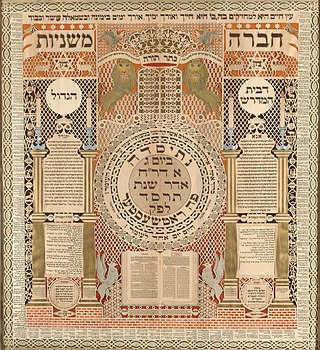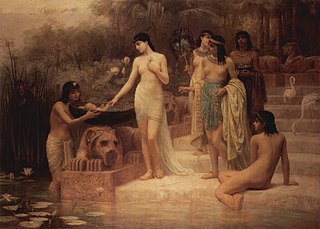
The Passover Seder is a ritual feast at the beginning of the Jewish holiday of Passover. It is conducted throughout the world on the eve of the 15th day of Nisan in the Hebrew calendar. The day falls in late March or in April of the Gregorian calendar. Passover lasts for seven days in Israel and, among most customs, eight days in the Jewish diaspora. Where seven days of Passover are observed, a seder is held on the first night; where eight days are observed, seders are often held on the first two nights, the 15th and 16th of Nisan. The Seder is a ritual involving a retelling of the story of the liberation of the Israelites from slavery in ancient Egypt, taken from the Book of Exodus in the Torah. The Seder itself is based on the Biblical verse commanding Jews to retell the story of the Exodus from Egypt: "You shall tell your child on that day, saying, 'It is because of what the LORD did for me when I came out of Egypt.'" At the seder, Jews read the text of the Haggadah, an ancient Tannaitic work. The Haggadah contains the narrative of the Israelite exodus from Egypt, special blessings and rituals, Talmudic commentaries, and Passover songs.

Midrash halakha was the ancient Judaic rabbinic method of Torah study that expounded upon the traditionally received 613 Mitzvot (commandments) by identifying their sources in the Hebrew Bible, and by interpreting these passages as proofs of the laws' authenticity.

Hillel was a Jewish religious leader, sage and scholar associated with the development of the Mishnah and the Talmud and the founder of the House of Hillel school of tannaim. He was active during the end of the first century BCE and the beginning of the first century CE.

Counting of the Omer is a ritual in Judaism. It consists of a verbal counting of each of the 49 days between the holidays of Passover and Shavuot. The period of 49 days is known as the "omer period" or simply as "the omer" or "sefirah".

The Haggadah is a Jewish text that sets forth the order of the Passover Seder. According to Jewish practice, reading the Haggadah at the Seder table is a fulfillment of the mitzvah to each Jew to tell their children the story from the Book of Exodus about God bringing the Israelites out of slavery in Egypt, with a strong hand and an outstretched arm.
Bahir or Sefer HaBahir is an anonymous mystical work, attributed to a 1st-century rabbinic sage Nehunya ben HaKanah because it begins with the words, "R. Nehunya ben HaKanah said". It is also known as Midrash of Rabbi Nehunya ben HaKanahמִדְרָשׁ רַבִּי נְחוּנְיָא בֶּן הַקָּנָה.
Hallel is a Jewish prayer, a verbatim recitation from Psalms 113–118 which is recited by observant Jews on Jewish holidays as an act of praise and thanksgiving.

Shemot, Shemoth, or Shemos is the thirteenth weekly Torah portion in the annual Jewish cycle of Torah reading and the first in the Book of Exodus. It constitutes Exodus 1:1–6:1. The parashah tells of the Israelites' affliction in Egypt, the hiding and rescuing of the infant Moses, Moses in Midian, the calling of Moses, circumcision on the way, meeting the elders, and Moses before Pharaoh.

Va'eira, Va'era, or Vaera is the fourteenth weekly Torah portion in the annual Jewish cycle of Torah reading and the second in the Book of Exodus. It constitutes Exodus 6:2–9:35. The parashah tells of the first seven Plagues of Egypt.

Bo is the fifteenth weekly Torah portion in the annual Jewish cycle of Torah reading and the third in the book of Exodus. The parashah constitutes Exodus 10:1–13:16. The parashah tells of the last three plagues on Egypt and the first Passover.

Pesachim, also spelled Pesahim, is the third tractate of Seder Moed of the Mishnah and of the Talmud. The tractate discusses the topics related to the Jewish holiday of Passover, and the Passover sacrifice, both called "Pesach" in Hebrew. The tractate deals with the laws of matza and maror, the prohibitions against owning or consuming chametz (leaven) on the festival, the details of the Paschal lamb that used to be offered at the Temple in Jerusalem, the order of the feast on the first evening of the holiday known as the Passover seder, and the laws of the supplemental "Second Pesach".

Afikoman based on Greek epikomon [ἐπὶ κῶμον] or epikomion [ἐπικώμιον], meaning "that which comes after" or "dessert"), a word originally having the connotation of "refreshments eaten after the meal", is now almost strictly associated with the half-piece of matzo which is broken in two during the early stages of the Passover Seder and set aside to be eaten as a dessert after the meal.

Behaalotecha, Behaalotcha, Beha'alotecha, Beha'alotcha, Beha'alothekha, or Behaaloscha is the 36th weekly Torah portion in the annual Jewish cycle of Torah reading and the third in the Book of Numbers. The parashah tells of the Menorah in the Tabernacle, the consecration of the Levites, the Second Passover, how pillars of cloud and fire led the Israelites, the silver trumpets, how the Israelites set out on their journeys, the complaints of the Israelites, and how Miriam and Aaron questioned Moses. The parashah comprises Numbers 8:1–12:16. It is made up of 7,055 Hebrew letters, 1,840 Hebrew words, 136 verses, and 240 lines in a Torah Scroll.

Pinechas, Pinchas, Pinhas, or Pin'has is the 41st weekly Torah portion in the annual Jewish cycle of Torah reading and the eighth in the Book of Numbers. It tells of Phinehas's killing of a couple, ending a plague, and of the daughters of Zelophehad's successful plea for land rights. It constitutes Numbers 25:10–30:1. The parashah is made up of 7,853 Hebrew letters, 1,887 Hebrew words, 168 verses, and 280 lines in a Torah scroll.
Passover songs are songs from the seder, the festive meal associated with the Jewish festival of Passover.

Ma Nishtana It is a section at the beginning of the Passover Haggadah known as TheFour Kushiyot, The Four Questions or "Why is this night different from all other nights?", traditionally asked via song by the youngest capable child attending Passover Seder.

The Washington Haggadah is a Hebrew-language illuminated manuscript haggadah created by Joel ben Simeon in 1478. He was a specialist illuminator of haggadot, who seems to have worked in both Italy and Germany, and whose style shows influences from the contemporary art of both countries. It is significant as it shows the vibrancy of Jewish art during the medieval period, scenes of daily life, and also highlights positive interfaith relations so often forgotten throughout this time.
Shelomith bat Dibri is the only woman named in the Book of Leviticus. Her story is found in Leviticus 24:10-23. The focus of the passage is on Shelomith's son who committed blasphemy and was stoned to death.
Ana BeKoach is a piyyut recited by Jewish communities at the end of Parshat HaKorbanot read during Shacharit, as part of Kabbalat Shabbat, and on each day from the second day of Pesach to the day before Shavuot during the 49-day counting of the Omer. It takes its name from the first two words of the first verse.

Telling the Story of the Exodus is a Torah commandment to tell the story of the Exodus from Egypt on the night of the 15th of Nisan every year. This commandment is the basis and the central motive for reciting the Passover Haggadah on the Seder night. The commandment applies to every person from Israel and includes all the stories mentioned in the Scripture about the miracles performed for the Children of Israel when they left Egypt.















